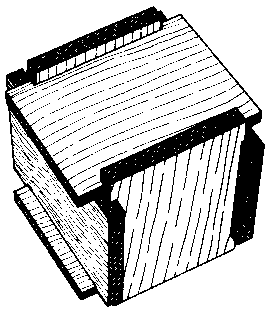
[Home] [Contents] [Figures] [Search] [Help]
[Next Page] [Prev Page] [ Next Chapter] [Prev Chapter]
Puzzles consisting of interlocking assemblies of notched sticks are often referred to as burr puzzles, probably from being pointed or spur-like in assembled appearance. By far the most familiar of all burr puzzles, and probably of three-dimensional puzzles in general, is the so-called six-piece burr. Its origin is unknown, but it has been traced back to at least 1803 in Germany, where it appears in a catalogue of G. H. Bestelmeier. Some persons know it as the Chinese Puzzle or Chinese Cross, probably because it has been mass-produced in the Orient since the early 1900s, but there does not appear to be any evidence that the idea originated there.
David Bruce has put forth the plausible conjecture that some of the earliest puzzles may have been but slight modifications of practical objects. For example, note the familiar interlocking box shown in Fig. 63, consisting of six notched boards. Did some whimsical box-maker decide to have fun one day in his spare time, or did he perhaps just run out of nails? Whatever, this may well have been the origin of the six-piece burr. With six identical pieces, as suggested by the illustration, it is clearly impossible to assemble. There are several obvious ways to modify one or more of the pieces to make it assemblable, and a good exercise for the amateur puzzle-maker is to see how many of these ways he or she can discover. With a penny slot, it becomes a toy bank - a good first puzzle for any youngster.
Fig. 63
General Discussion
Burr No. 305
Difficulty Index and Burr No. 306
Higher-Level Burrs and Bill's Baffling Burr
| ©1990-2005 by Stewart T. Coffin For questions or comments regarding this site, contact the chief metagrobologist: |
[Next Page] [Prev Page] [ Next Chapter] [Prev Chapter]